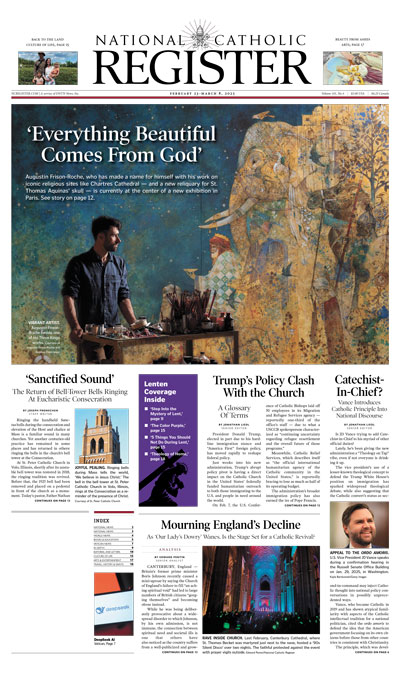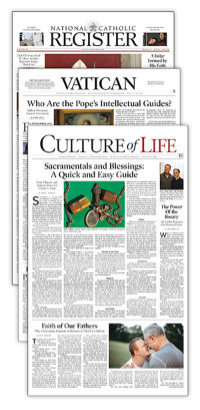The New Lectionary
Three years ago, as pastor of Mary, Queen of the Rosary parish in Spencer, Mass., I lifted the Lectio-nary to read the Gospel. As I did, the binding broke and the page with the Gospel I was about to read floated away like an errant angel. I decided it was time for a new Lectionary.
But I wasn't the first. Almost 20 years earlier, the scholars who had translated the New American Bible were contemplating a revision of their work, based upon advances in the study of sacred Scripture. They too decided it was time for a new Lectionary.
And shortly before that, the Congregation for Divine Worship in Rome was reflecting on the experience of 10 years of use of the first postconciliar Lectionary for Mass. Their studies revealed the need for a new introduction and expanded cycles of readings. They also decided it was time for a new Lectionary.
So it was that in 1981, the Holy See published a second typical edition of the Ordo Lectionum Missae, which was subsequently approved by the bishops of our country as the Lectionary for Mass for Use in the Dioceses of the United States of America. Parishes were permitted to begin reading from it on the First Sunday of Advent 1998. The new Lectionary for the United States incorporates the revised translation of the New Testament from the New American Bible. The Old Testament is still being retranslated by Scripture scholars.
What's in It
The new Lectionary adds many new cycles of readings for particular feasts and includes all the selections from Scripture found in the Roman Ritual (for baptism, confirmation, holy orders, marriage, and the rest). One of the first differences readers will notice is that all readings are broken into sense lines in order to facilitate effective proclamation.
The new Lectionary begins with an extensive introduction, which explains the theology of the Word of God in the life of the Church and in her liturgy. The theological section is followed by a reflection on the roles of the reader, deacon and priest in the Liturgy of the Word and the principles by which the Lectionary for Mass is organized.
Many of the readings from the Lectionary were first assigned to their particular feasts in the first centuries of the life of the Church. Your parish assembly is thus joined in a special way, not only with all who read from the Lectionary today, but with all who have proclaimed the mysteries of our faith throughout the ages.
Each of the readings from Scripture have been translated from the original Greek and Hebrew into English as spoken in the United States today. This is particularly appropriate since “American English” differs somewhat from British or Australian or any sort of English spoken in other parts of the world.
Language About God
Another often-discussed aspect of the translation deals with the question of so-called inclusive language. Inclusive language is either vertical (words referring to God) or horizontal (words referring to people). While some have advocated the changing of the Scriptures to purify them of what they perceive as patriarchal (exclusively male) images of God, neither the bishops nor their translators have ever advocated such an approach. Although the metaphors used in the Scriptures to describe God are predominantly male, this does not, of course, mean that God is a man! God is neither male nor female. He is the totality of all that is good and true and beautiful.
Such a reflection is a good subject for a homily or other type of catechetical reflection. It is not, however, a good reason to change the inspired Word of God. No gendered references to God are changed in this translation of the Lectionary for Mass. All references to God are translated with precision and fidelity.
Language About Man
Horizontal inclusivity usually refers to words used in reference to people. Most of the time this concerns what lexicographers call “universal collectives,” that is, words used to designate “sets” of people. English has a particularly difficult time with such words. It used to be, several centuries ago, that English had a gendered universal collective for each sex: all of the male sex were referred to as “vir,” while all of the female sex were referred to as “vif.” All male and female persons together were, as today, referred to as “man.”
For a variety of complex reasons (which no one seems to fully understand), vir and vif fell out of usage. They were replaced by “man,” which referred to all masculine persons; and “woman,” which referred to all female persons. Confused yet? It gets worse! For this has resulted in a double job for the single word “man”: It means both the universal collective (all persons) and the gendered collective (all masculine persons).
In recent years, some have suggested that the word “man” should be avoided or replaced with other words in order to avoid this confusion. Yet, as contemporary writings, journalistic stylebooks, movies and popular speech demonstrate, the word “man” as a non-gendered universal collective is still widespread across our country.
Thus the new Lectionary for Mass avoids the word “man” when there is the danger of confusing its universal meaning (all persons) with the gendered (all masculine persons) use of the word. Sometimes, however, the only word capable of fully expressing the idea of the non-gendered universal collective is the word “man.” Such is the case in the creation account, where “God created man” is the translation in the revised Lectionary for Mass.
Brothers and Sisters
Another example of this complex question comes in relation to the Greek word adelphoi. In Greek, the term literally means brothers and is often used in the vocative case (forms of address) to greet men and women. Those of us with a few more graying hairs can recall a time when the same situation existed in American English. It is hard to imagine someone beginning a speech to a mixed group today with the phrase, my brothers, but this was not quite so rare just a few short decades ago.
The Revised New American Bible translates St. Paul's vocative use of adelphoi as brothers. This is because Paul uses the word as a “technical term” to referred to the baptized as the adelphoi. It is unfortunate that we do not have a single word in American English that could be used to refer to both brothers and sisters. The fact is, we no longer have such a word.
In the Lectionary for Mass, therefore, whenever the word adelphoi is used in the vocative, it is translated as brothers and sisters. When it is used in the non-vocative sense, the context determines the precise translation.
‘Maximum Possible Fidelity’
Which is precisely the point I wish to make. The principles applied by the Scripture scholars, liturgists, theologians and most all the bishops, in preparing this new Lectionary for Mass was maximum possible fidelity to the sacred Scriptures. Where the Greek or Hebrew text was inclusive, an attempt was made to express that inclusivity in the English translation. Where the Greek or Hebrew text was exclusive, the gendered reference of the original was accurately translated into English. The holy Scriptures were never changed for the sake of inclusivity or any other agenda. The Scriptures were passed on (traditio) as best those involved in this work could accomplish that important task.
The revised Lectionary for Mass that is now proclaimed at Sunday Mass does contain a moderate degree of horizontal inclusivity, just as American English, as it is spoken in our country today, utilizes a moderate degree of horizontal inclusivity. More notably, however, the translation is more accurate, easier to proclaim, and specifically crafted to assist your deacon or reader or priest to effectively proclaim the Word of God.
The Revised New American Bible of the Lectionary for Mass will eventually be the only translation authorized for use in the liturgy in the United States of America. Thanks to the close collaboration of the Holy See and our bishops' conference, it is a Lectionary uniquely enabled to proclaim the Word of God in our day and age. May we receive it with hearts ready to embrace the command that the bishop gives to each newly ordained deacon as he hands him the Book of Gospels: believe what you read and practice what you preach.
Father James P. Moroney is executive director of the Secretariat for the Liturgy of the National Conference of Catholic Bishops.
- Keywords:
- May 16-22, 1999











